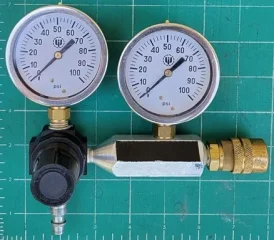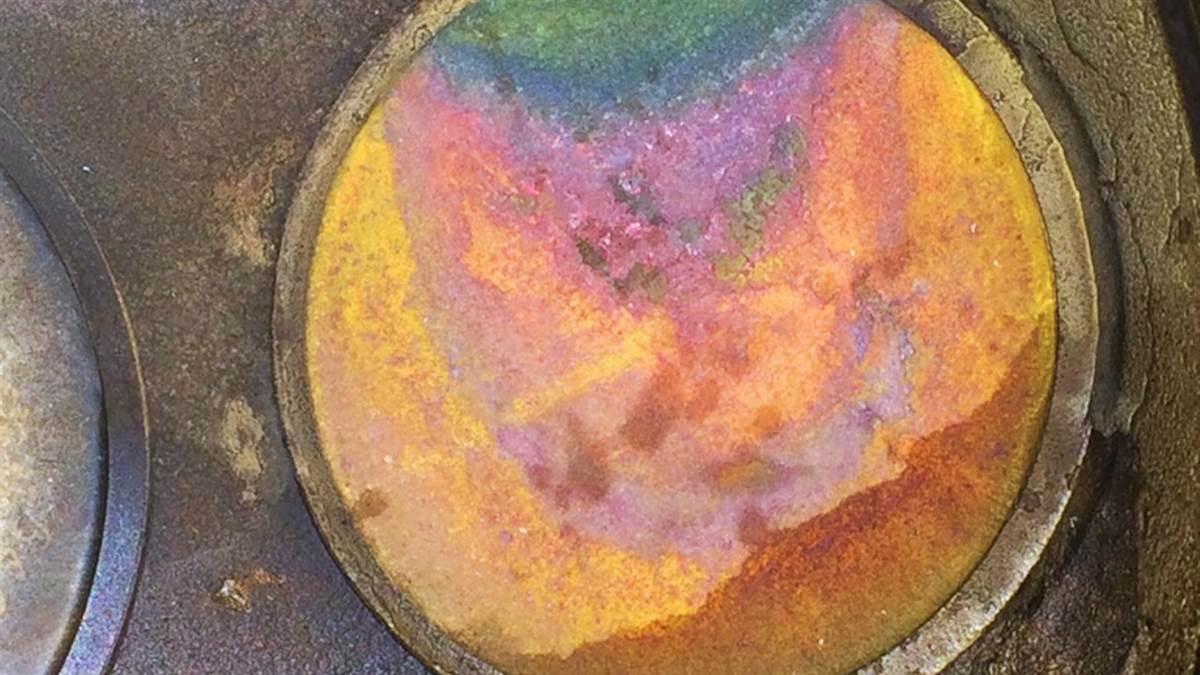This thread has provided an interesting discussion on leak-down testing. I hope to add to our understanding of such measurements by providing recent results of leak down tests performed on an engine I’ve been working on. The marque is irrelevant aside from the fact that it has 2 cylinders, a 2.75” bore, and rings with excessive end-gap. The particular leak-down tester employed in this undertaking was made by a friend and has a provision to alter the size of the “bleed orifice” between the 2 gauges in a systematic and accurate way. More specifically, a Mikuni air correction jet is employed to vary the orifice size, thus there is a full range of appropriate size orifices available. The specific air correction jets employed in this experiment were a 0.5 (0.5 mm orifice, ~ 0.0197” dia) and a 1.0 (1.0 mm orifice, ~0.0394” dia). The 1.0 mm jet was chosen because it would be within 0.0006” dia of the standard 0.040” bleed orifice used for an engine of this size in the FAA test protocol, and referenced earlier in this thread. An image of the tester is shown below, where the air jet is installed in the necked down section of the body where it threads into the regulator.
View attachment 81411
Because the discussion in this thread has covered both high- and low-pressure testers, and discussion/debate has ensued on the merits thereof, I decided to perform the leak-down test at several different pressures, specifically 100, 50 and 25 psi with each of the 2 orifice sizes recited above on both cylinders.
Before discussing the test results I’d like to make a few points regarding the leak-down test, especially in light of the 2 orifice sizes employed here. If the tester is fit with a 0.5 mm bleed orifice (between 1st and 2nd gauge) this is the leak rate that cylinder leakage is compared to. Let’s now consider what happens when the bleed orifice is increased in size, e.g., changing it from a 0.5 mm orifice to the 1.0 mm orifice. Although the orifice diameter has only doubled in size, the orifice area increases by 4X, thus, in use we are now comparing engine leakage to a reference leak 4X larger than when the small orifice was employed, and in so doing have significantly decreased the sensitivity of the leak-down test. Earlier in this thread reference was made to the 0.040” orifice being suitable for engines with less than 5” bore, whereas a 0.060” orifice was required for engines of greater than 5” bore. Here again, going from a 0.040" orifice to a 0.060" orifice the dia only increases by 50%, but the orifice area increases by 2.25X, so again large step down in leakage sensitivity, which is consistent with use on a larger cylinder with larger ring gaps, more surface area, and hence, more leakage .
Hopefully the foregoing discussion reinforces that the smaller the bleed orifice in the tester the more discriminating the leak-down test becomes. And to the contrary, the larger the bleed orifice, the less sensitive the leak-down test becomes.
The person that built the subject leak-down tester employed here was working on 600 cc crotch rocket race engines at the time (small engines/small bores) and was unhappy with the results he was getting from his Snap-On leak-down tester, as the results were not as discriminating as he desired (everything looked too good). Thus, he fit the gauge with the 0.5 mm orifice to be more discriminating. As I started performing a standard 100 psi leak down test on my project I was initially horrified by the amount of leakage observed - in the range of 20-50% - and truly concerned about the soundness of the engine! Shortly thereafter I recalled that this tester was fit with the small bleed orifice, thus was highly discriminating, and in turn likely responsible for the high leakage observed. It was at this moment that I decided to perform some systematic screening tests at the pressures recited above with both orifices. These tests were conducted on a cold engine and since I was seeking differences in readings rather than absolute values, I reasoned that I needn’t slave over a hot engine to generate useful data.
Before performing leak-down tests on the engine I wanted to see how the gauge alone responded when pressurized with no outlet. This would point out any disparities in readings from gauge to gauge as well as possibly identifying any leaks in the system. At test pressures of 100, 50, and 25 psi, and with both the large and small orifice, the 2nd gauge gave readings of 98, 49.5 and 25 psi respectively. Thus, a small correction was required at the 2 higher test pressures and was made on the tabulated results.
With one cylinder set at TDC, the test was 1st conducted with the 0.5 mm orifice and immediately thereafter the orifice was changed to 1.0 mm and the test repeated. The results of these tests are presented graphically below.
View attachment 81412
The results in the graph show that with the standard large 1 mm orifice (red data) leakage values for both cylinders are excellent and average in the range of 2-3%, and that cylinder 2 is slightly tighter across the board than cylinder 1. The results also show that with the large bleed orifice the test is relatively insensitive to test pressure as the results are nearly identical at all test pressures. I breathed a sigh of relief after seeing these results and realizing that the test engine was in fact nice and tight with very low leakage, vs the initial observations with the small orifice that showed large leakage rates.
When the orifice was changed to the smaller (0.5 mm) more discriminating orifice the results were dramatically different exhibiting significant leakage values and very clearly showing the superiority of cylinder 2 to cylinder 1. With the smaller orifice the test also exhibited a significant dependence on test pressure, i.e., leakage increased with decreasing test pressure.
All of the above results were repeated several times and the same values were recorded each time the test was performed. Hopefully the above discussion clarifies how some of the testing parameters employed in leak-down testing impact the results. Furthermore, the results might guide someone wanting to conduct a slightly more discriminating leak down test if the need arose.
As always, comments, questions, corrections, etc welcomed.

 www.aircraftspruce.com
www.aircraftspruce.com


